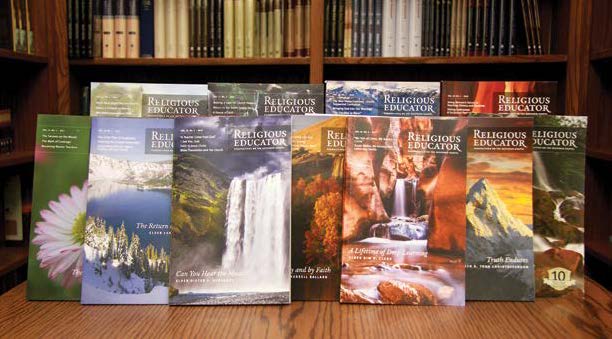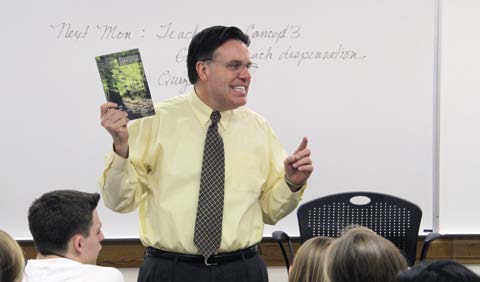Twenty Years of the Religious Educator
Brad Wilcox and Timothy G. Morrison
Brad Wilcox (brad_wilcox@byu.edu) was an associate professor of ancient scripture at BYU when this was written.
Timothy G. Morrison (timothy_morrison@byu.edu) was an associate professor of teacher education at BYU when this was written.
Where were you twenty years ago? That was before the terrorist attacks of 2001 and the heightened airport security that followed. Do you remember when the vote between George W. Bush and Al Gore dangled on a few hanging chads in Florida? President Gordon B. Hinckley was the President of The Church of Jesus Christ of Latter-day Saints in 2000 and dedicated the Conference Center in Salt Lake City. A lot happened back in the year 2000, but perhaps something that may have escaped your notice was the beginning of a journal at BYU called the Religious Educator. From that beginning, the journal has grown to be a significant resource for gospel scholarship throughout the world. The Religious Educator is now celebrating its twentieth anniversary. This article tells the story of how the journal came to be.
Creating the Journal
In the past, BYU Religious Education sponsored a number of graduate programs, which allowed professors and students to engage in scholarship. On 3 May 1972, Religious Education discontinued its doctoral degree programs. This gave fewer opportunities for faculty to team with students in scholarly research. As a faculty member at the time, Robert L. Millet noticed the resulting decline in faculty scholarly productivity. When he became dean in 1991, he began meeting with Stanley A. Peterson, who was the associate commissioner/
In 2000 only one issue was produced. It was edited within Religious Education, primarily by Andrew C. Skinner, the editorial manager and chair of the Department of Ancient Scripture at the time, and Lori A. Soza, an administrative assistant, with help from Connie R. Lankford, Laura Card, and Cory Crawford. The first issue received a positive response, and Millet determined to continue publication of the journal, with two issues in the following year and three issues each year thereafter.
 A selection of covers over the past twenty years. Photo by Brent R. Nordgren
A selection of covers over the past twenty years. Photo by Brent R. Nordgren
Associate dean Paul Y. Hoskisson invited Richard Neitzel Holzapfel, professor of Church history and doctrine, to take on production of the journal as part of his full-time responsibilities and bring the journal under the supervision of the RSC. Hoskisson asked Holzapfel to increase the rigor of the journal and clarify its purpose within the Latter-day Saint community. Previously, professors had tailored their writing for BYU Studies or the Ensign, an official publication of the Church. BYU Studies had a general academic focus, while the Ensign was aimed at general Church membership. Holzapfel envisioned the Religious Educator as finding a home somewhere between these two publications, with a particular focus on gospel teaching. He also wanted to align the journal with the stated aims of a BYU education: to be spiritually strengthening, intellectually enlarging, character building, and leading to lifelong learning and service. Holzapfel approached Stephen Hales, a professional designer, and Ted D. Stoddard, a business writing professor at BYU.
He set up a review board tasked blind peer review and with ensuring that the journal maintained an appeal to mainstream Church members and avoided topics that might be considered fringe or extreme. Mary Jo Tansy of the BYU Creative Works office handled distribution of the journal. Charlotte Pollard, an administrative assistant in the RSC, and later Joany Pinegar, the publications coordinator for the RSC, helped coordinate the peer-review process.

In 2001, R. Devan Jensen, who had worked as an editor for the Ensign at the time, was hired by the RSC to oversee book editing and edit the redesigned Religious Educator. This team of Holzapfel, Stoddard, Jensen, and Hales worked together for seven years to publish the journal, with Stoddard and Jensen handling the editing and Hales, Jimmy Salazar, Brandon Barney, and Kelly Nield designing and typesetting. In 2004, Holzapfel became the publications director of the RSC, which included continuing as editor of the Religious Educator. In 2008, Brent R. Nordgren joined the team as a production supervisor, overseeing design and securing images, captions, and permissions. Robert L. Millet, no longer serving as dean, replaced Holzapfel from 2010 to 2012 with the assistance of Richard E. Bennett, associate dean of Religious Education. Dana M. Pike, professor of ancient scripture, was the next editor of the journal until the end of 2013. The following year, Thomas A. Wayment, professor in the Department of Ancient Scripture at the time, became publications director of the RSC and editor in chief. He was followed in 2018 by Scott C. Esplin, professor in the Department of Church History and Doctrine.
Making a Difference
Initially, the three areas of focus for the journal were outlined as gospel teaching, doctrinal understanding, and Church history. One additional focus that appeared quickly in the Religious Educator was to include articles by and interviews with General Authorities and officers of the Church. Often, these have been adapted from addresses given at various conferences or reprints of devotional addresses.
At the university conference in Provo in 2016, Elder Kim B. Clark, Commissioner of Church Education and General Authority Seventy at the time, highlighted two objectives of the Church Educational System. He said, “First, we need to educate more deeply and more powerfully than we have ever done before—more than anyone has ever done before. . . . Second, we have a sacred responsibility to do all we can to help many more of the rising generation and many of the older generation to obtain that kind of education.”[1] The Religious Educator has proven to be a valuable tool in fulfilling these two objectives and building the kingdom of God.
Notes
[1] Kim B. Clark, “The Lord’s Pattern” (Brigham Young University conference address, 22 August 2016), https://
